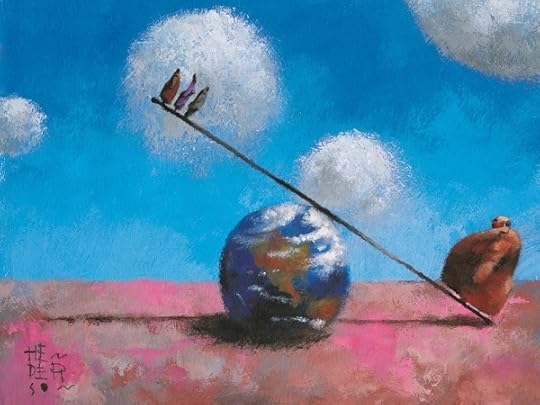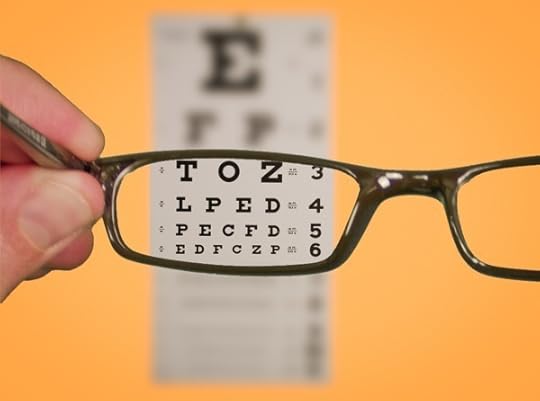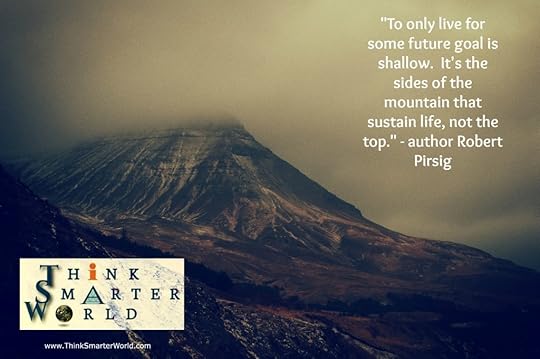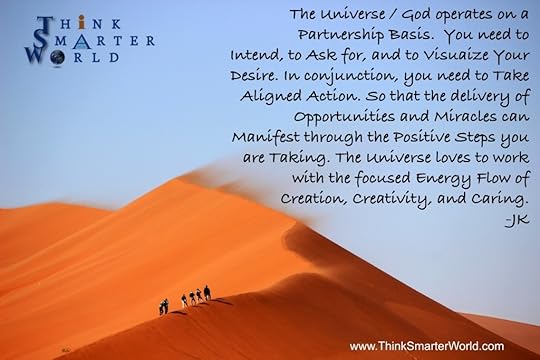Jay Kshatri's Blog, page 13
November 29, 2014
Kurt Vonnegut’s Sage Advice on Art, Creativity, and Life [Quote]




In 2006, students from Xavier High School were given an assignment to write to their favorite authors—five of the students chose Kurt Vonnegut. Vonnegut’s response, the only one the class received, encapsulates essential wisdom unbounded by craft or circumstance.
What I had to say to you, moreover, would not take long, to wit: Practice any art, music, singing, dancing, acting, drawing, painting, sculpting, poetry, fiction, essays, reportage, no matter how well or badly, not to get money and fame, but to experience becoming, to find out what’s inside you, to make your soul grow. Seriously! I mean starting right now, do art and do it for the rest of your lives. Draw a funny or nice picture of Ms. Lockwood, and give it to her. Dance home after school, and sing in the shower and on and on. Make a face in your mashed potatoes. Pretend you’re Count Dracula.



The post Kurt Vonnegut’s Sage Advice on Art, Creativity, and Life [Quote] appeared first on Think Smarter World.
November 17, 2014
The 3 C’s of a Modern and Enlightened Society

[image error] Creating, Creative, and Caring
If we look around in most advanced nations of the world, there is surely no shortage of people Creating, being Creative, and Caring:
61,299,500 cars have been produced around the world this year so far (Creating)
$545 Billion dollars of advertising worldwide will have been created by end of 2014 (Creative)
$345 Billion dollars will be given to charities in just the U.S. alone in 2014 (Caring)
The numbers are impressive. But for the three C’s to provide us a more enlightened society, they need to work together. In other words, when in the act of creating, we insist on being creative to the best extent possible, and then add to that mix the act of caring about how our creation and creativity impacts others in a positive and helpful way, then we unleash the best of what capitalism can do for us. Unfortunately, much of the time, most people and companies let Creation and Creativity act independently and the moral grounding of Caring is not brought to the dance. In fact, our legal requirements for corporate directors explicitly state that they must focus on maximizing shareholder wealth and profit. To do otherwise, risks bringing on shareholder lawsuits.
Certainly, we have had some corporate leaders take some steps in the direction of what’s called a “triple bottom line focus” (profits, people, planet). But usually, this needs to always be couched in a way that whatever you do as a public company can always be linked back to maximizing profit. So, if the Coca-Cola Company for example, helps to alleviate water shortages in some parts of the world, they are doing it primarily because climate change has disrupted the water supply for their beverages and is thus hurting profitability. In this case, then, working on sustainable practices helps their long term profitability. This of course is good for them and for the local population they are helping. But it still leaves a wide gap in what truly needs to be done to improve things in many different areas. And, it also is usually a reactive measure (finally done when an issue is going to hurt profits, rather than a proactive act done to benefit society).
Benefit Corporations (B Corps)
But there is hope. A better, more caring form of corporate structure has been created, which allows Caring to be part of the corporate mission. It’s called the Benefit Corporation (B Corp). It is now possible to be registered as a B Corp in 26 states, including Delaware. You can also be certified as a B Corp (by meeting a set of criteria that shows how well you align with the mission of the Benefit Corporation framework). As of today, there are 1,140 registered B Corporations in the U.S.
B Labs explains the background on Benefit Corporations as follows:
A benefit corporation is a new class of corporation that voluntarily meets higher standards of corporate purpose, accountability, and transparency. Benefit Corporations: 1) have a corporate purpose to create a material positive impact on society and the environment; 2) are required to consider the impact of their decisions not only on shareholders but also on workers, community, and the environment; and 3) are required to make available to the public an annual benefit report that assesses their overall social and environmental performance against a third party standard. Becoming a benefit corporation gives entrepreneurs and investors an additional choice when determining which corporate form is most suitable to achieve their objectives. Does benefit corp affect our tax status? It doesn’t. Your company can still elect to be taxed as a C or S corp. Benefit corp status only affects requirements of corporate purpose, accountability, and transparency; everything else remains the same.
Benefit Corporations in essence take away the legal jeopardy that typical U.S. corporate structures place on companies for doing the right thing for all stakeholders in the name of profit maximization. They allow us to put another “C” word back into play – “Conscious Capitalism”.
-Jay Kshatri
www.ThinkSmarterWorld.com
Resources:
Benefit Corp Resource Center
B Lab - a nonprofit organization dedicated to using the power of business to solve social and environmental problems.
The post The 3 C’s of a Modern and Enlightened Society appeared first on Think Smarter World.
Partnership with the Universe [Quote]




Create, be Creative, and definitely Care…



The post Partnership with the Universe [Quote] appeared first on Think Smarter World.
October 21, 2014
20/20 Consciousness

Photo Credit: kenteegardin via Compfight cc
Consciousness
Websters:
a : the quality or state of being aware especially of something within oneself
b : the state or fact of being conscious of an external object, state, or fact
c : awareness; especially : concern for some social or political cause
So to simplify – Consciousness is Inner Awareness, External Awareness, and Concern for Others.
To me, the definition implies that to gain high levels of inner and external awareness and concern for others, requires increasing levels of knowledge, mindfulness, wisdom, and compassion.
The definition also implies increasing consciousness means increasing clarity, to see things as they really are. A lower level of consciousness would imply lower levels of clarity, confusion, and an increased level of ignorance.
I’ve thought at times that your level of consciousness is similar to the results of an eye exam. The optometrist will have you look through the machine and place various filters (lenses) in front of your eyes until you can see clearly. Some people require more adjustment to get to 20/20, some people less.
So simple right, we all just need to get new “Consciousness Glasses” and move to 20/20. The problem is that there isn’t a universally accepted definition of 20/20 consciousness among everyone in society at large. In spiritual circles, yes. Unity consciousness, Oneness, Non-Duality - the concept that everything and everyone is part of one unified consciousness – is widely understood to be the end point when you arrive at pure consciousness. It implies that there is no Self and Other, no Us and Them.
In Unity Consciousness you don’t Go to War, you Go to Love.
Because going to war, is attacking yourself. Not something you would readily do if you had 20/20 consciousness.
What else wouldn’t we do if we had 20/20 Consciousness?
We wouldn’t be obsessed with winning and losing
We would move from “Self Service” to Service to Others
We wouldn’t allow others to suffer needlessly (poverty, homelessness, hunger)
We would not seek to benefit ourselves by harming others (or actively or passively supporting the harming of others – through our business decisions, the sports we play and watch, and our purchasing and consumption decisions)
We would not support the harming of the Environment
We would not harm our own bodies through drugs, chemicals, over-stress, lack of exercise, and poor dietary choices
The list could go on and on, but as I’m sure you would agree, the level of clarity required to get to 20/20 consciousness is a high bar indeed. And with that in mind, it would seem we have a Crisis of Consciousness in mega proportions.
How can we raise our level of Consciousness in the Modern World?
Study Enlightened Minds of the Past – Buddha, Christ, Lao Tzu, Rumi
Study Awakened Minds of the Present – Shawn Achor, Tony Burroughs, Pema Chodron, Paulo Coelho, Wayne Dyer, Thich Nhat Hanh, Michael Singer, Eckhart Tolle, Marianne Williamson
Develop a Mindfulness Practice – Meditation, Focused Awareness – and seek to connect spiritually with Universal Consciousness
Look for ways to practice Unity Consciousness in your daily life – Commit a random act of kindness, Let the other person win sometimes, Learn something new about someone (or a group of people) and see their point of view (ultimately realizing that their point of view is not who they really are – it’s just a temporary phenomenon).
Amplify Your Knowledge – Be proactive in harnessing the most nutritious information, knowledge, and wisdom from around the world that the internet now allows us to do with a touch of a button. There is a method to this…
Spend significant time in Nature every day. Any place with lots of trees, vegetation, water if possible, is a place full of elevated energy levels. Why? Because natural living things are directly connected to and emanate from Source Consciousness. Their energy is undiluted. Us humans, with our free will and internal mental gymnastics are raising and lowering our energy levels all the time. Since we are all energy beings, immersing yourself in pure, unadulterated energy helps clean and re-order your particular energy stock. It’s no accident when great minds “venture into the woods” to clear out their heads and reconnect with divine and creative inspiration.
In general, just as we get physically healthier if we ingest more healthy and wholesome foods, we raise our consciousness by consuming those items that are created by higher level consciousness – books, music, movies, television, nature, and of course discussions with fellow humans who are closer to 20/20.
Einstein was Right
Albert Einstein once said that “No problem can be solved with the same level of Consciousness that created it”.
So, asking the same people who got us into a mess is often a recipe for frustration. Of course, people learn from mistakes and failure and increase their level of consciousness. If that particular group managed to do that, then fine. They’ll be able to clean up the mess. If not, then well, you know…
Learning from mistakes and failure is the key. But unfortunately, it’s very easy in our society to stay marinated in lower level consciousness for a long time. Too many of us keep watching the same news programs (24/7 stream of the same issue in a million different ways), reading and watching the same media, listening to the same people, reading the same types of books, and so on. We may think we are absorbing different things, but essentially it’s the same (or lower) level of consciousness just in different disguises.
Collective Consciousness or Collectively Unconscious?
Our individual consciousness when put together at a group level is the Collective Consciousness of a society, a country, and the world at large. Just as at the individual level our thoughts are energy and what we think about we attract into our lives, at a group level the same holds true. So if a state or country is composed of citizens operating at lower levels of consciousness, then it’s a problem for the whole group and it benefits all of us to help raise the consciousness of others.
At a tactical level, for capitalism and democracy to function effectively it requires knowledgable and moral participation of citizens.
When collective consciousness is low (substandard levels of knowledge, mindfulness, wisdom, and compassion), then both of these institutions break down and don’t deliver the results they are capable of delivering. The more we can raise our own level of consciousness and help others raise theirs, the better these two pillars of society will function for all of us.
I Gotta Get Out of Here
Have you ever noticed that artists, writers, entrepreneurs, and other creatives, go out of their way to be in more vibrant or natural surroundings and to be around other like minded people? They say it helps their creativity.
In a world which is totally made up of energy, how you interact with it can either raise your energy level or reduce it.
Lower consciousness is slower, denser, and less light than higher level consciousness. Have you ever walked into a room, visited a town, or met someone and felt the energy around and inside of you go lower (or higher)? Be aware of that next time you have the opportunity and listen to your instincts. As you develop that awareness, you’ll find yourself seeking out people and places that are more in tune with the higher level of consciousness you crave.
So shine up the lenses on those Consciousness Glasses. You’ll see the world with much more clarity, help others do the same, and in the process Change the World!
Here are a few resources to help you on the path:
Buddha at the Gas Pump: In depth video interviews with every day people who have awakened to higher states of consciousness, with host Rich Archer
21 Ideas to Free Your Mind from Mass Media, Think Smarter World
The Miracle of Mindfulness: An Introduction to the Practice of Meditation, by Thich Nhat Hahn
Seeing the Oneness of our Reality , Think Smarter World
~Jay Kshatri
www.ThinkSmarterWorld.com
The post 20/20 Consciousness appeared first on Think Smarter World.
October 13, 2014
Move Over Power-Nap, Make Room for the 5-Minute Mini-Meditation

Photo Credit: keioffice26 via Compfight cc
If you are a regular meditator, you already know the great benefits meditation provides for improving overall health, lowering stress, and increasing your capacity for mindfulness. Some people meditate 20 minutes once a day, others perhaps even longer and more frequently. I generally achieve one 30-45 minute session a day and this usually works well for me. However, I came to realize that on some days, that one session was not enough. In my case, I found that even though I had meditated in the morning, I could end up in a non-ideal state later in the morning or afternoon based on a number of different scenarios:
An urgent interruption disturbs my work flow and causes me to lose the focus I had achieved. This is a problem as psychologists long ago found that on average it takes a person up to 25 minutes to regain the concentration they had achieved prior to the interruption.
Some annoying or distressing piece of information reaches me that tugs at the edges of my consciousness. In this case the Amygdala (the reptilian part of the brain is activated – where stress and fear are centered) and what we need is to calm that down so that the Neocortex(the driver of spatial reasoning and conscious thought) can take back control.
Perhaps a solution to a creative problem is not coming to me as easily as I would like. Meditation, even of brief duration helps to enhance creativity and problem solving.
In these scenarios (and a few others…), I have found that taking a 5-minute mini-meditation is all I need to bring my mind back to a tranquil state and regain my focus quicker after an interruption. And in cases of finding answers to problems, the power of meditation allows me to calm the mind and more easily tap into universal consciousness for the answers during or shortly after the meditation break.
The beauty of the mini-meditation is that it can be done anywhere – you don’t need to go to your “special meditation place”. You can do it right at your desk if you are at work, in your car while waiting to pick up your children from school or sports, or anywhere really where you can just gently close your eyes, and focus on your breathing for 5 minutes.
I have found several things help to amplify the effects of the 5-Minute Mini-Meditation:
Don’t worry about proper posture. With limited time, the key thing is to get into a comfortable and relaxed position quickly.
With limited time, go deeper into your breathing than perhaps you normally do in your normal meditation practice. Breathe deeply and let your diaphragm and belly expand as much as possible.
Don’t stress over the duration of your mini meditation session. It doesn’t matter if you meditate for 2, 5 or 10 minutes. Let your body and mind be your guide. You’ll know when you’ve gotten what you need.
Gently come out of the meditative state – no need to negate the effort by immediately checking your email and text messages. Sit for 30 more seconds and just let the calm and relaxation sink in.
Repeat the process throughout the day as needed. I find a mid morning and mid afternoon meditation tune-up works well for me. Just as we are now finding that our bodies need to intermittently move all day for optimum health and longevity, so too does the mind need to be periodically brought back to its more natural, calm state. Give the 5-Minute Mini-Meditation a try. I think you’ll find that things in small doses sometimes are just what the doctor ordered.
~Jay Kshatri
The post Move Over Power-Nap, Make Room for the 5-Minute Mini-Meditation appeared first on Think Smarter World.
October 9, 2014
What-If?

I have recently been finding that simple phrase to be a very strong source of motivation. I’m captivated by its simplicity and its power. The mere saying of that phrase to any scenario that you are facing immediately takes you into the realm of possibility. And, dwelling in possibilities is where you want to be most of the time. Why, because we live in a Universe of infinite-possibilities that are available for us to access with our imaginations. What-If is the catalyst to enable us to move beyond hesitation and fear.
What-If allows us to begin the process of imagination in a way that removes limits.
If we could ask them, I have a feeling the great inventors of the past lived a lot of their lives in the space of What-If: Walt Disney, Leonardo Davinci, Picasso, Steve Jobs, the Wright Brothers, Thomas Edison, and many more.
In a world of too many choices, too much information, and too many ideas it’s easy to get stuck. Our minds are readily able to (consciously and subconsciously) identify the reasons why something won’t work (or already has been done) rather than giving us the reasons it could happen. Asking What-If sprays some WD-40 on the creativity neurons to get them firing again and simultaneously lowers the flame of the amygdala – the seat of the fight or flight response in the brain – so that the more calm neocortex can do its work.
But What-If isn’t just for dreaming and brainstorming. It’s also a good planning tool. Asking a series of What-If’s on the same topic naturally leads you down the trail of planning out the steps to achieve your objective. The first What-If lays out the major objective. Then, you identify all the major obstacles and apply What-If solutions to all of them. In this way you continue to peel away the layers of resistance to unearth the path to achieving your desired objective.
I can imagine the thought process Steve Jobs went through in creating the Apple Stores. “What-If we created a retail experience so spectacular that people would think of it as a cool place to visit not just to shop?”. That thought would naturally bring up a number of resistance points that would then need to have additional What-If’s applied to them as follows:
Resistance Points:
1 . Computer Stores aren’t sexy: “What-If we created a minimalist and artistic feel to the stores that complimented the look and feel of sleek Apple products.”
2. People who work in computer stores aren’t well liked. People would rather buy on-line: “What-If we raised the bar on hiring and only brought in very knowledgeable experts who have a passion for Apple products?”
3. We don’t have enough products to fill an entire store: “What-If we stocked the stores with accessories for various apple products in order to become a one-stop shop?”
Hopefully you see the flow. In this way,
resistance is not a stopping point, but a launching point to creative problem solving.
Gerald Nadler and William Chandon in their book Smart Questions, reveal that in their research, the best thinkers are holistic in nature and are oriented towards the future:
“They see themselves as not solving problems but creating solutions. Creating solutions is oriented towards the future. It aims to understand situations in terms of where people want to be years from now before deciding what to do today. It recognizes that problems exist in time, and so solutions must be living solutions that are adaptable, flexible, and ready to change as needs change. Solution creation is innovative as well as people centered. It is warm, fluid, and effective.”
Asking the What-If question is inherently an act of boldness. We are surrounded in our professional and personal lives with people and scenarios (including our own conscious and subconscious minds) which are very good at alerting us to why something can’t be done. The What-If is the perfect antidote to all the nay-saying. In particular, because it’s non-threatening. You are theorizing an option, a possibility. You haven’t taken a strong position or chosen a firm direction yet. Those things induce fear, so why go there right away? What-If’’s allow us to remain in the land of possibilities where creativity can bloom unfettered.
The What-If also leads us into the world of powerful manifestation. When creating intentions, when we can make them big, vivid, and daring that’s when they become really interesting. In a world full of unlimited abundance and possibilities, why would we settle for anything less? Creating What-If scenario’s leads us naturally into creating a visual representation of what we are thinking about. Once we decide that a particular What-If scenario is very appealing to us, we can set it as an intention and let the power of our thoughts attract it into reality.
Try using the power of “What-If”, I am confident you will find it empowering. In fact, you may even want to keep a notebook (or a note in Evernote) with various What-If’s you come up with and refer back to them from time to time for inspiration. I find it a very useful brainstorming and motivational tool.
~Jay Kshatri
www.ThinkSmarterWorld.com
The post What-If? appeared first on Think Smarter World.
October 8, 2014
To Only Live for Some Future Goal is Shallow… [Quote]








robert pirsig
The post To Only Live for Some Future Goal is Shallow… [Quote] appeared first on Think Smarter World.
September 29, 2014
You Can Reboot [Video]
Looking for Love in All the Wrong Places

Photo Credit: Reilly Lievers
Remember that song by Johnny Lee – Looking for Love (in all the wrong places)?
Or, how about the old story of the guy who lost his keys in the parking lot at night? He was looking under a lamppost when a passerby asked where did he lose them. The guy pointed out towards the darkness, and replied “someplace over there”. The passerby asked, “so why are you looking here?” The guy replied, “because it’s easier to see here”.
So many times in life we end up having a misalignment of what we want, and where we should go to get it.
It’s easier to go to the doctor and take a pill than eat better and go to the gym. Or as the song implied, you usually won’t find your future wife or husband in the midst of a smoky bar.
Alignment of Desire and Action is often difficult to achieve in our modern world. Especially given the unlimited choices that we have. I’ve certainly been fooled by the lure of the “lamp post” many times. So how do we know which path or which option to take?
I have a simple algorithm to use:
Follow the path of the idea, media, experience, opportunity, or person that takes you in the direction of greater integration, collaboration, unity, and love.
That’s the path the Universe is on. Everything else is at best a detour. In some ways it’s like driving the wrong way on a one way street. You’re either going to get lost, hurt, or worse.
Products, companies, and organizations can exhibit this trait as well. Apple embraces connectivity across all its products and ensures that its hardware and software work seamlessly together. Microsoft – not so much. Starbucks shows great care for its employees in terms of wages, healthcare, education, and other benefits. Walmart – not so much. You can do your own comparison with television shows, radio personalities, news organizations, politicians, states, countries, sports, movies, music, and more. Support the one’s working to harmoniously connect, support, and unify us by strategically exercising your purchasing power, your vote, your attention, and your time.
You get the idea. If we want to be more in alignment with Love in both our personal and professional lives, we should make more conscious choices. We just need to shine our own light beyond the lamp post…
~Jay Kshatri
www.ThinkSmarterWorld.com
Learn more by reading the series Seeing the Oneness of our Reality.
The post Looking for Love in All the Wrong Places appeared first on Think Smarter World.
September 22, 2014
Seeing the Oneness of our Reality – Part Five

Photo Credit: Riccardo Maria Mantero via Compfight cc
This is Part Five of a Five Part Series of Seeing the Oneness of our Reality. See previous installments: Part One, Part Two, Part Three, Part Four.
In this five part series, we will explore the meaning of Oneness – the concept of one interconnected consciousness that gives rise to all beings and matter. There is no self and the other, they are one and the same. In my opinion, it is the understanding and experience of Oneness that is the key ingredient necessary for us to progress forward as individuals and for society to solve its biggest problems. Think about it, progress on any of the major issues we face – rising poverty, food and water shortages, climate change, rising energy prices, growing inequality, deteriorating education standards, immigration etc – are all stale-mated at the current time because we have become hyper-polarized as a society in terms of us versus them, what’s mine is not yours, and winning is everything. Yet, collectively, we have enormous technology, intellectual, and financial resources to solve or at least significantly mitigate almost any problem, if we would only cooperate. But if we think we are separate and different from “the other person or group”, that cooperation will be a long time in coming, if ever. In this five-part series, I’ll take you on a tour of what the latest information form the world of Science, Spirituality, and Psychology is revealing about our true reality. These things have been spoken about by ancient spiritual traditions for thousands of years, but our modern world took a detour around 400 years ago and is now finally catching up. Hopefully more will awaken to our underlying interconnected and shared reality and we can finally move forward to realize our true potential. -JK
Part Five
Nirvana, Non-Duality and The Taming of the Ego
If everything and everyone is part of a single energy plane, then you and I are the same, and connected. Non-Duality means that there is no Self or Other; rather, it is all One. Yes, we have different physical forms, but underneath, at a sub-atomic and spiritual level, we are identical. If then I am mean to you, I’m essentially mean to myself. Therefore, the ultimate goal—the meaning of nirvana—is to experience this non-duality, this utter lack of separateness between all of us.
The way to achieve that is to act with love toward all people. Love is when you see the other as yourself. When we say we would be willing to give our life for another person, it’s because we see them as ourselves and we would certainly want to help ourselves. Unconditional love is true love, full of acceptance, compassion, and forgiveness.
Living in the Moment without the Ego
When we come to the conclusion that we (people, all living things, and all material form as well) are all connected through a universal life energy force, this of course has huge implications for how we live our lives moment to moment and day by day.
Much of what we’re taught growing up is how we are different from others, and a separation arises in our minds between “us and them.”
We’re judged in terms of our grades in school, our athletic achievements, our “artistic gifts,” and our successes in our jobs and professions. Literally from birth, we are rated, sorted, measured, and classified. It can be no wonder then that we naturally develop a tendency toward conflict, the need to win, and the need to be right.
But if what metaphysics and science are pointing to is a universal connection among all of us, then when we engage in conflict, aren’t we just hurting ourselves? Think about it: we are from the same Source, connected to each other in an electrical field. The field, like an electrical circuit, has feedback loops—when I give energy, it comes back to me; when I take energy, it is taken from me as well. In this way, it is synonymous with the Christian teaching of “those who give will receive.” Or from Asian traditions, the concept of Karma’s cause and effect.
It is also said that the very things we push against or resist keep appearing in our lives until we learn the concepts of acceptance, forgiveness, and love.
When we absorb this concept, it is hard to look at people and situations the same again. If we are the same, if we are connected, then a good way to view others is that we are co-creators in this life we’re sharing. In any situation you encounter, if you believe the others participating with you in that moment are co-creators who have come together and have the ability to collaborate and raise (or lower) the energy level of a situation, it can dramatically alter your approach to life. So the natural question of course is:
What if the other person doesn’t see the world in the same way? What if they are still in the mindset of conflict, competition, or aggression?
Well, if we go back to the concept of being connected at a subatomic level in the field, then our approach and our positive energy can have an effect on the person(s) we are interacting with. If our approach is based on acceptance, understanding, forgiveness, and love, it will have an affect on the other person, lower their resistance, and the positive vibration will come back to us.
In any given situation, we can choose to take the view that conflicts are due to people’s having their own challenges and that how they deal or interact with us is not personal. We can give them the benefit of the doubt and know that they are on a journey of self-learning through this life just as we are, and though we may not be synchronized today, we come from the same place. We can choose to be of assistance to them through our understanding and acceptance and view them as co-creators with whom we can collaborate toward win-win outcomes.
In this way, you in fact have an enormous amount of power in any situation. You control your own reaction, and by eliminating the separation between you and someone else, you provide them with that power, achieving a much better outcome for all involved. And although you may not experience the result you want right away, a positive gift of acceptance and forgiveness is always returned.
A related outcome of this mode of thinking is that we reduce or lose our need “to be right.” Our view or position doesn’t have to be accepted immediately by the other person. We start realizing that we are all in it together and though we should certainly put forth our ideas, thoughts, and constructive feelings, the fact that they aren’t accepted right away is ok.
People need time—we are all seeing the world through a different set of experiences and filters. The more patience we have with each other, the more we move toward common understanding and shared experiences.
Sometimes we can actually see people becoming more aware and realizing the Oneness among us in real time. Recently you may have seen some politicians change their stance on certain social issues—gay marriage for example—because someone in their family revealed themselves as gay. Now, after decades of being against gay marriage, they announce they are for it. What happened is that what they previously saw as “other,” they now see as themselves. They love their children, and since their children are not “other” but the same as they are, then they must love others as well because they, too, are one and the same.
As love was the answer in allowing those in the above instance to erase the separation, so too does love have influence in other situations. When someone who strongly opposes climate change policies, for example, personally experiences a major climate event causing great loss of life, property, and large financial impact, climate change is suddenly not some abstract concept happening to someone else. There is no other—there is us—and since these people care deeply about their own, they now recognize that we are in it together. In both instances, experiencing love and caring firsthand were necessary to erase the need of the human mind (ego) to create separation and highlight differences between people.
In sum, we of course hope that not every politician or business leader must experience profound personal trauma in order to make decisions that are in the best interest of all people. I’m not sure our country or the planet could afford that! We simply need them (and ourselves) to understand that we are all the same, all part of one energy stream of consciousness, and that when we help others, we help ourselves; when we hurt others, we hurt ourselves.
Love is the only real fuel for our lives; everything else is merely fumes.
Mastering Our Thoughts,
Mastering Our World
Over this five part series, we have learned that the leading edge of science, the Eastern spiritual traditions, Christian mysticism, revelations from past life regressions, near-death experiences, and channeled communication from the Source all suggest the following:
We are all spiritually interconnected in a vast Energy Matrix that is connected to the Universal Consciousness.
Our thoughts are high-frequency energy, and thoughts turn into physical manifestations in our world.
We are thinking all day long (and night through our dreams).
This implies that we are creating nonstop! If that’s true, then it would be a safe next step to say that we need to be on guard regarding our thinking all the time, right?
That’s exactly what successful business entrepreneur Trevor Blake has learned over the years and explains so beautifully in his 2012 book Three Simple Steps. It is one of the most unique takes on the Law of Attraction, and Trevor goes to great lengths to show you how he implements his three steps in his daily life. I highly recommend you read his book. Not only is the information important in transforming our lives, but Trevor’s life story of rising from childhood poverty in England to entrepreneurial success is a moving and motivating one.
Trevor calls his process of minding his thoughts “guarding his mentality.” He has learned to be ever-vigilant in not letting negative thoughts infiltrate his psyche. He discovered this key insight during his difficult childhood. When everyone around him was negative, Trevor discovered that when he changed his focus away from what they were saying, spending time in nature and at the library, he was able to create uplifting thoughts, and he started to attract positive change into all areas of his life. What was once thought impossible for a poor child living in rural England became possible through his removing the negative and believing strongly that he would achieve whatever he wanted. He did not let doubt enter into the equation.
The key takeaway from his experience is that in our modern-day world, we are constantly faced with a barrage of negative information —from the sensationalist news programs on TV, to irritated colleagues at work, and even angry parents at an eight-year-old’s soccer game on the weekend. When that stimuli enters our minds, our brain goes to work and creates mental images of that negative information. Apart from causing us emotional distress at the time, our mind also acts like a giant search engine looking to turn thoughts (energy) into reality (matter). Unwittingly, we start attracting similar negativity to our lives.
Our mind doesn’t know if a thought is good or bad, or if we want it or not. It just converts without discrimination.
Even simply watching the nightly news after work can lead to unintended consequences. Even though there are numerous things that actually go right in a given day, they manage to cram ninety minutes of the worst of humanity into a thoroughly depressing program. Are we better off by knowing every single horrific event that has happened that day? To some extent, there are current event topics that a well-rounded and aware person may want to know about. But many media outlets don’t present thoughtful and carefully balanced information. And what do we do with the information once we know it—does it change what we actually do on a day-to-day basis?
Typically no, but our mind does something. The negative stimuli are turned to mental images, which then lower our energy levels and attract other low-energy events to our lives. If, after watching the news, you have images of death, economic collapse, and political gridlock now burrowing through your subconscious, then your mind’s search engine will try to manifest other unhappy things into your life as well. On the flip side, it is no accident that “positive investor sentiment,” “unbridled confidence,” “enthusiastic optimism,” and “a glass-half-full attitude” seem to have a multiplier effect on our lives.
When we shift our minds from what we don’t want to what we do want in our lives, magic happens.
We must focus on the affirmative and think I am healthy and happy not I don’t want to be sick and lonely anymore. The mind’s search engine says in the first case: Oh, you’re happy and healthy and therefore your circumstances need to match this. In the second statement, the mind’s search engine says: Oh, you’re sick and lonely and therefore your circumstances need to match this. In both cases, you get what you think about.
The challenges are how to control the negative stimuli coming to us in the first place and then how to control our reaction to it. The first part is done by adopting the shift from a reactive to proactive mindset. We need to be very particular about what sources of information and entertainment we consume and the people with whom we choose to interact. That said, we aren’t able to choose our environmental circumstances all the time —that co-worker or boss isn’t going away anytime soon. And your child will be very sad if you tell her she has to quit the soccer team because some of the other parents feel winning is life and death, calling forth every bit of anger in their cheering to help defeat the other team. What to do?
The answer is that it is our reaction to the annoying stimulus (not the stimulus itself) that allows us to remain free of its bad effects.
Going back to the Four Noble Truths of Buddhism, we suffer when we become attached to arising thoughts. If we release those thoughts—let them slip by us like passing cars on the highway—then we simply observe and stay calm. Trevor Blake quotes his mom Audrey, a truly enlightened soul, on how she taught him to control his thoughts: “When I was growing up, she was always telling me to pause before I spoke, ‘to give your reaction time to sort itself out.’”
The best way I know to develop our ability to control thoughts, and our reaction to them, is meditation. A daily meditation practice strengthens our brain’s ability to stay centered and calm and be clear of unwanted thoughts. Meditation is usually associated in the West with stress reduction, and that is one of its greatest benefits. But as we have just discussed, it also can help you master your thoughts, and thoughts are essential to creating the reality we truly desire.
~Jay Kshatri
www.ThinkSmarterWorld.com
To more deeply understand the harmful effects of the ego and the remedy for them, turn to modern-day spiritual master Eckhart Tolle’s A New Earth, Awakening to Your Life’s Purpose. You can in fact watch a free online course on the book that Oprah did with Eckhart back in 2008—there’s one video segment for each of the ten chapters:
The post Seeing the Oneness of our Reality – Part Five appeared first on Think Smarter World.





